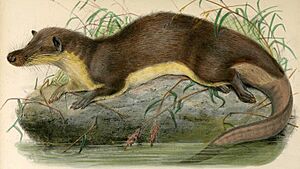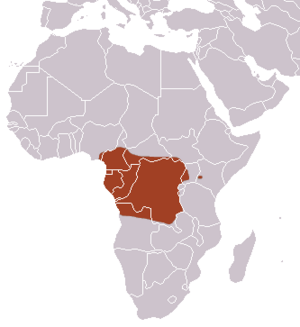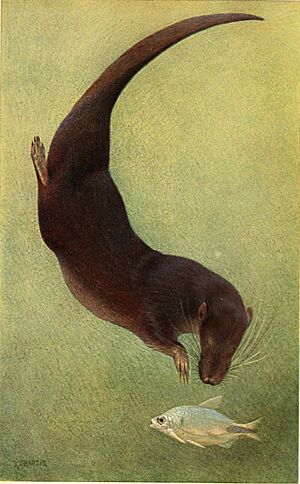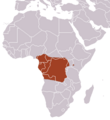Giant otter shrew facts for kids
Quick facts for kids Giant otter shrew |
|
|---|---|
 |
|
| Conservation status | |
| Scientific classification | |
| Genus: |
Potamogale
|
| Species: |
velox
|
 |
|
| Giant otter shrew range | |
The giant otter shrew (its scientific name is Potamogale velox) is a special kind of mammal that lives partly in water and eats meat. It's found in the rainforests of central Africa, from countries like Nigeria all the way to Zambia. You can also find smaller groups in Kenya and Uganda. This animal likes to live in streams, wetlands, and slow-moving rivers. It is the only species in its group, called Potamogale. Even though it's called a "shrew," it's actually more closely related to animals called tenrecs, which live in Madagascar.
Giant otter shrews are active at night and hunt for other animals in the water. Despite its name, it's not a true shrew or an otter. People call it an "otter shrew" because it looks a bit like an otter with its flat face, stiff whiskers, and strong tail. It also has some features that remind people of true shrews.
Contents
What Does a Giant Otter Shrew Look Like?
The giant otter shrew looks a lot like a small otter. It has a long, flat tail that it uses to swim by moving it from side to side, just like a fish. Its nose is covered with stiff hairs, and its nostrils are flat and protected. The shrew has soft, thick fur, which is especially silky on its tail.
It has small eyes and ears that you can see from the outside. Its fur has two layers: a thick undercoat and rougher guard hairs on top. Its back is dark brown, and its belly is whitish or yellowish. The tail is covered in short, silky fur and is flattened on the sides. This helps it swim by wiggling its body and tail like a fish or a crocodile. Its legs are short and don't have webbing, so it doesn't use them for swimming. When it's on land, it walks flat-footed.
The giant otter shrew can weigh between 300 grams (about 10 ounces) and 950 grams (about 33 ounces). Its body, not including the tail, is about 29 to 35 centimeters (11 to 14 inches) long. With its tail, it can be 53.5 to 64 centimeters (21 to 25 inches) long.
Where Do Giant Otter Shrews Live?
Giant otter shrews are originally from central Africa. They live in the southern parts of Nigeria, and then spread eastward through countries like Equatorial Guinea, Gabon, and the Central African Republic. You can also find them in Chad, the Republic of Congo, the Democratic Republic of the Congo, South Sudan, and down to northern Angola and Zambia. There's also a small group living between Uganda and Kenya, especially in the Kakamega Forest.
Giant Otter Shrew Habitat
These animals love fresh water in the rainforest. They prefer places like fast-flowing rivers, streams, swamps, and rivers near the coast. During the rainy season, some might move to smaller forest pools. They can live at different heights, from sea level up to 1,800 meters (about 5,900 feet). River banks are great places for them to build their homes and have their babies. These shrews dig burrows with an entrance hidden underwater, much like otters do. They stay in these burrows during the day and become active in the afternoon.
How Do Giant Otter Shrews Behave?
The giant otter shrew builds its burrows in cracks and holes along riverbanks. It lines its nest with dry leaves, which is also where it has its young. They often change their burrows. When they are looking for food, otter shrews often stop to groom themselves. If they want to travel upstream, they usually walk along the riverbank. Then, they swim downstream. Their night-time hunting routine is very regular and they can cover up to 800 meters (about half a mile) each night. They also visit special piles of feces that are hidden, which they probably use to mark their territory.
Giant otter shrews are solitary animals, meaning they live alone. One shrew usually has a territory of about 500 to 1,000 meters (about 1,600 to 3,300 feet) of stream.
What Do Giant Otter Shrews Eat?
The giant otter shrew hunts at night. It finds its food mainly by touch and smell in and around calm pools of water. Each time it dives, it only stays underwater for a few seconds. It searches for prey both in the water and along the bank, using its sensitive vibrissae (whiskers) and its sense of smell. It doesn't seem to use its eyesight much for hunting. It likes to hunt in areas where it can quickly hide if it feels danger.
When it catches prey, it uses sharp bites. Sometimes, it holds the prey down with its front feet. For crabs, it might flip them over to attack their softer underside. They usually avoid crabs that are bigger than 7 centimeters (about 2.7 inches) across. What they like to eat can be different for each shrew; some prefer crabs, while others like frogs or fish. They eat frogs headfirst, and they pull fish apart into smaller pieces. They always eat their prey on the riverbank. Giant otter shrews also eat insects, mollusks (like snails), and freshwater prawns. In zoos, they have been known to eat 15 to 20 crabs in one night.
Lifespan of Giant Otter Shrews
Giant otter shrews do not live long when kept in captivity, like in zoos. They tend to get sick very quickly, often living only between 1 and 14 days.
Reproduction and Life Cycle
Giant otter shrews have their babies during the wet or rainy season. They usually give birth to one or two young at a time, once or twice a year. Male shrews travel long distances through the water to find mates. It is thought that males might fight each other during the wet season to find a partner.
Conservation Status
Currently, the giant otter shrew is listed as "Least Concern" by the IUCN. This means that its population is not declining fast enough to be in a more serious category. However, its numbers are still going down. One big problem for this species is soil erosion, which happens when forests are cut down, especially in Cameroon. While they can handle streams that are a bit cloudy from time to time, they don't use streams that are very muddy from erosion and deforestation. Some shrews also drown in fishing nets or traps. Scientists are still studying how human activities affect these animals. They are also hunted a lot for their skin.
Images for kids






